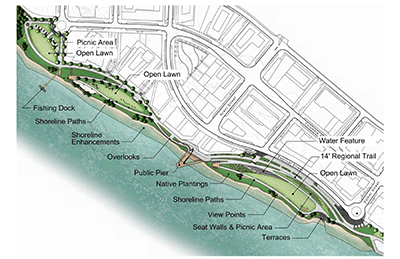The redevelopment of the old Boise-Cascade Mill site in downtown Vancouver has long been a top priority for city leaders. And while the mixed-use project has the potential to be a game-changer for the city, the key to its success may very well lie at the water’s edge.
The 32-acre project will include one million square feet of office space and 250,000 square feet of retail space, including proposed restaurants, a hotel and residential condominiums. At this time, the development group is finalizing negotiations with suitors for the proposed amenities.
But perhaps the most notable amenity – one that developers anticipate will attract new life to the area – is a planned 7.3-acre park running east-west along the water.
“We envision a wonderful space for city events,” Julie Hannon, Vancouver Parks and Recreation Director shared. “Concerts, special events and festivals would be fantastic in this setting.”
Hannon said the park will allow for an expansion of events, while some current activities may be moved the site to take advantage of what the space will offer.
Designed with care
Columbia River Waterfront Park presents an opportunity to reconnect the city with the river, taking advantage of an amazing resource that is such a big part of the region and its culture, Hannon said.
Several areas will be “carved out” of the otherwise open space. A 46-foot fishing dock, Vancouver’s first along the waterfront west of Interstate 5, will highlight the structural additions. Year-round access and utilization of the park is expected.
Informal lawns that can be used for a multitude of activities will dominate the park with thoughtful viewpoints and vistas spliced in to maximize the setting along the water. The park will connect to the Waterfront Renaissance Trail that stretches from Wintler Park to the east before meandering westerly into downtown.
“There is a concerted effort to get the shoreline right the first time,” Hannon added. “The surprisingly strong current [of the Columbia], the shipping lanes being so close to shore and natural erosion will be accounted for from the beginning.”
Terracing and steps along with methods of armoring along the shoreline will bolster the banks. Otherwise, the river’s edge will be left in as natural a state as possible.
Design cues for the park and much of the new development will capture the character of the Columbia River itself, the historical culture of Vancouver and public art from local artists.
Such a major undertaking cannot happen overnight. The waterfront project will unfold in phases over the next several years. Finalized designs and construction readiness are set to be completed this summer and fall. The first construction is underway – the expansion of Esther and Grant streets which slip under a pair of new railroad bridges. These will be two of three streets that will connect downtown with this section of the waterfront.
Private development in the new space is slotted to break ground next spring with work on the park itself in the summer of 2015. The first phase of the park should be finished the following summer.
Gramor Development is leading the $1.3 billion project.
“Working with the city has been great. They are ‘all in’ on this project,” said Barry Cain, president of the Tualatin-based development company.
Being an instrumental part of the vision of the project since the beginning has been extremely helpful throughout the planning process, Cain said.
“Coordinating all the phases of construction – roads, the park and the buildings, helps to make all the projects work together,” he said.
On schedule
According to both Cain and Hannon, the waterfront park, along with the rest of the 32-acre project, is tracking along according to schedule.
A proposed oil terminal at the Port of Vancouver was one of few concerns throughout the process, Cain admitted. However, the developer said he is confident that it won’t be an issue moving forward.
“Funding, funding, funding,” Hannon said, referencing the only other challenge the project has grappled with.
Grants for infrastructure improvements to the major arterial roadways, connector streets and walking paths have been critical to the initial phase of the project.
Columbia Waterfront LLC, a private investment group led by Gramor Development, has worked closely with the city, including the allocation of the riverfront park footage.
“It is a big deal, raising money and receiving grants for a project like this,” Cain admitted.
That said, Hannon expects Requests for Quotes (RFQs) and other construction documents to be completed this summer and was pleased to share that the city has several grants pending to aid in the process.








